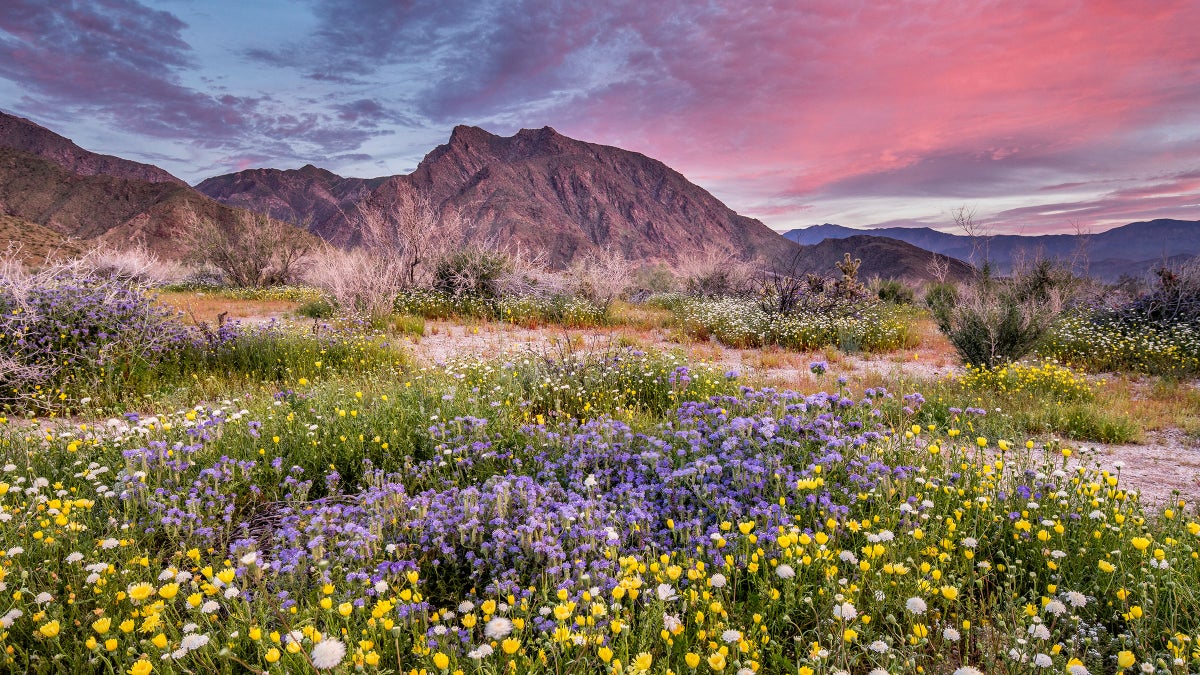Products You May Like
Get full access to Outside Learn, our online education hub featuring in-depth fitness, nutrition, and adventure courses and more than 2,000 instructional videos when you sign up for Outside+
Sign up for Outside+ today.
In his documentary series “The National Parks,” filmmaker Ken Burns extolled the populist nature of what he refers to as “America’s Best Idea”—the fact that those amazing federal lands are available to people from all walks of life. But what about the countless folks who don’t live near federal land?
According to the National Association of State Park Directors (NASPD), there are 6,792 state park units in the U.S., and that’s just the beginning. In addition, the National Association of State Foresters says state forest agencies oversee nearly 74 million acres. Admittedly, state parks are generally much smaller in size than their federal counterparts, but they’re cumulatively vast, individually unique, and ecologically and socially important.
You want to embark upon a spur-of-the-moment backpacking trip and you live in New York City, you don’t go to Yellowstone. You go to Harriman State Park.
“Most people do not live in a place where they can visit a national park or forest without taking a week of vacation,” says Paul McCormack, director of state parks for the South Carolina Department of Parks, Recreation and Tourism and vice president of the NASPD. “State parks serve to introduce people to the outdoors; they are also economic engines for a lot of rural areas, as well as protecting a lot of resources.”
What follows is a geographically diverse, but by no means exhaustive, homage to some of the country’s great state parks. They’re all home to top-shelf backpacking and an array of stunning landscapes, from desert vistas to rainforests to skyscraping peaks. If none of these are within a day’s drive of you, don’t worry—there are plenty more where they came from.
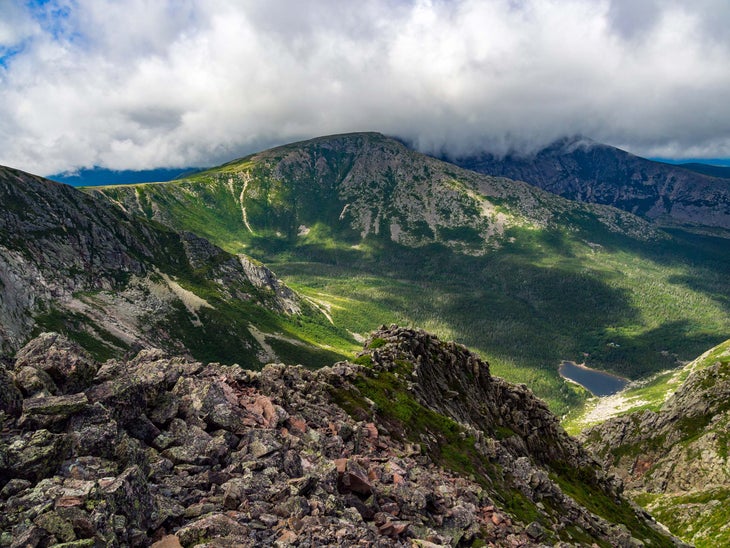
Baxter State Park, Maine
Ancestral home of the Penobscot
Baxter (like Madonna or Ronaldo, it only needs one name) boasts 209,000 acres, 75 percent of which are wildlife sanctuary and home to large populations of moose and black bears. It’s also home to the northern terminus of the Appalachian Trail—5,269-foot Mt. Katahdin—which makes it one of the more recognizable state parks in the country.
Baxter is the centerpiece of a triad of protected lands that includes the 92.5-mile Allagash Wilderness Waterway and the 87,500-acre Katahdin Woods & Waters National Monument, which was only established in 2016.
A great dayhike:
From Roaring Brook Campground, follow Hamlin Ridge Trail to Pamola Peak, across the Knife Edge of Katahdin to Baxter Peak, then back to Roaring Brook via Chimney Pond. The trail is 11 to 12 miles, depending on which route you take off the mountain.
A great multiday hike:
Roaring Brook to Russell Pond to Davis Pond, over to Chimney Pond, and back to Roaring Brook. “You can stretch this from four or five days to 10 by checking any number of interesting corners of the park,” says Don Hudson, who served on the board of directors for Friends of Baxter State Park.
Know before you go:
Permits are required for almost all visitation.
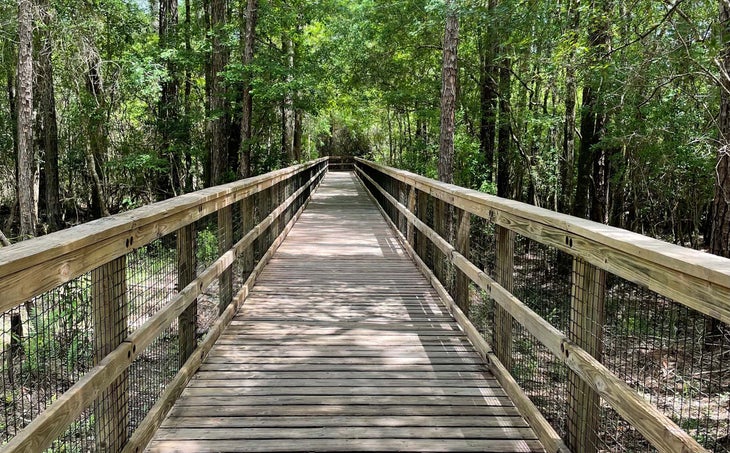
Blackwater River State Forest, Florida
Ancestral home of the Creek, Choctaw, and Seminole
Located in the Panhandle, Blackwater River State Forest (BRSF) is the largest in Florida. Thirty miles of its namesake waterway flow through the BRSF, home to the world’s largest remaining concentration of longleaf pines, which once covered more than 60 million acres in the southeastern U.S. According to Recreation Administrator David Creamer, the BRSF is home to numerous endangered and threatened species, including the gopher tortoise, the Eastern indigo snake, the red-cockaded woodpecker, and the panhandle lily.
A great dayhike:
Traverse crimson bluffs and sandy beaches on the 8.8-mile Juniper Creek Trail.
A great multiday hike:
A multiday paddle down the Blackwater River intersects several trails and camping is allowed on sandbars.
Know before you go:
There are alligators but, according to Creamer, they are a rare sight. There are also a delightful variety of poisonous snakes, including diamondback and ground rattlesnakes, water moccasins, copperheads and coral snakes. Watch your step.
Paul Bunyan State Forest, Minnesota
Ancestral home of the Ojibwe
According to the fortuitously named Forest Eidbo of Minnesota’s Department of Natural Resources, the state’s Division of Forestry manages about 4.5 million acres, which makes it one of the most expansive systems in the country.
Located near the headwaters of the Mississippi River, the 105,000-acre Paul Bunyan State Forest isn’t Minnesota’s largest, but it punches above its weight class with unique geography and self-propelled outdoor recreational opportunities.
“The Paul Bunyan consists of a terminal moraine,” says Forest Supervisor Mike Lichter. “It has hilly terrain, gravelly soil, and hills with overlooks, which is unusual in northern Minnesota.” A deep system of lakes in the Paul Bunyan provides some of the cleanest water in the state.
A great dayhike:
The 3.8-mile Waboose Lake Loop passes through old-growth pine forest as it encircles its namesake body of water.
A great multiday hike:
The 25-mile section of the North Country Trail accessed from the Highway 64 trailhead traverses the Paul Bunyan through rolling hills and dense white pine forest.
Know before you go:
Northern Minnesota’s reputation for mosquitoes is well-deserved. Ticks are also an issue. This is Lyme disease country.
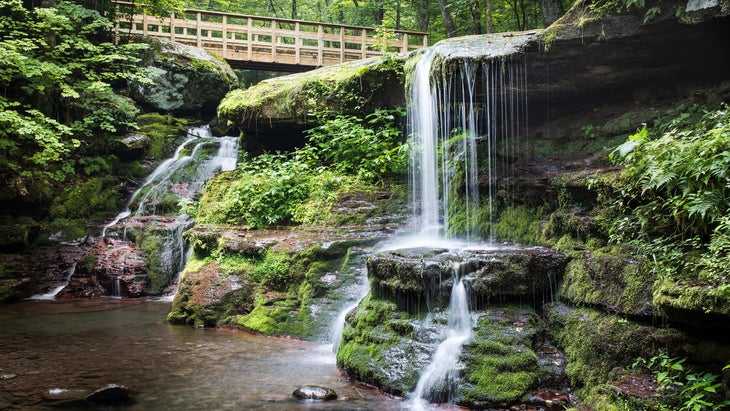
Catskill Park, New York
Ancestral home of the Esopus
The sprawling Catskill Park exists in the shadow of the larger Adirondack Park to its north, but it’s just as beloved by New Yorkers. Like Adirondack Park, there’s a lot of private property within the park boundaries, but that still leaves a forest preserve in the tens of thousands of acres just a few hours from New York City.
According to Wendell George, president of the Catskill Mountain Club, three things come to mind when talking about the park: trees, water, and wildlife.
“This is where southern hardwood forests meet the northern-style boreal forests,” he explains. “New York City gets 90 percent of its drinking water [from here], and it’s so clean that the city doesn’t have to filter it. The park has been protected for 114 years and has tremendous biodiversity—black bears, bobcats, coyotes, foxes, and bald and golden eagles.”
One last fun fact? This is where fly fishing in America was born.
A great dayhike:
The 3.75-mile Giant Ledge Trail offers views of the range from five open ledges.
A great multiday hike:
The 26-mile Devil’s Path is considered by many to be the most difficult hike in the eastern U.S., thanks to punishing elevation gain and loss, and tricky scrambling
Know before you go:
Crowds are enough of an issue that a local advisory group recently suggested a parking reservation system. If that’s not in place when you intend to visit, plan to arrive early.
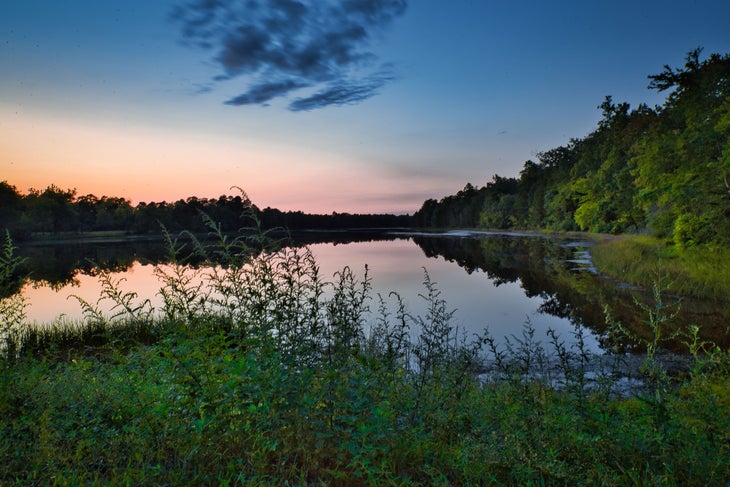
Wharton, Brendan T. Byrne, and Bass River State Forests, New Jersey
Ancestral homeland of the Kechemeche
To the surprise of many, densely populated New Jersey has an extensive system of public lands, including the 1.1-million-acre Pinelands National Reserve, the first place in the country to earn that designation. The Pinelands National Reserve covers nearly a quarter of the state and consists of numerous land-management components, including the 122,880-acre Wharton, the 38,000-acre Brendan T. Byrne, and the 23,563-acre Bass River state forests.
Much of the Pinelands are flat and sandy, which might sound boring, but actually supports a unique ecosystem. That’s according to Carleton Montgomery, executive director of the 5,000-member Pinelands Preservation Alliance, who explains, “the water table is very high, so there are a lot of wetlands that support significant biodiversity found nowhere else.” The forests consist largely of oaks and—true to the area’s name—pines. “This is different from other temperate forests because of the highly acidic, sandy soil. There are really no invasives replacing the native ecology. The water that flows from these forests is pure.” Home to 299 bird species, 59 reptile and amphibian species, and 91 fish species, the Pinelands are beloved by birders, anglers, and anyone who loves the croaking of frogs.
A great dayhike:
On the 9.4-mile Mullica River Trail, you can see beaver, whitetail deer, great blue heron, and red-tailed hawk.
A great multiday hike:
The 53.5-mile Batona Trail, designed to connect the three state forests, offers multiple overnight options.
Know before you go:
The sandy soil of the Pinelands interior is not conducive to insect propagation, but it’s a different story on the lowlands closer to the Atlantic shoreline, which is home to impressive populations of mosquitoes and biting greenhead flies during the warmer months.
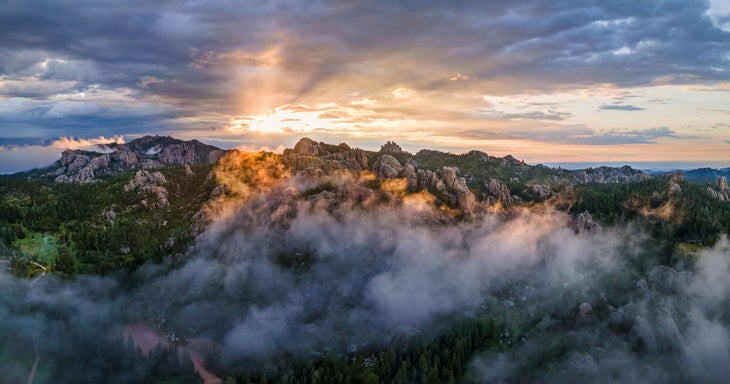
Custer State Park, South Dakota
Ancestral homeland of the Lakota Sioux
Nestled between Wind Cave National Park and the Black Hills National Forest, Custer helps form one of the largest stretches of public land in the northern Great Plains and is among the best wildlife-viewing parks in the country. Home to a bison population that numbers about 1,400, Custer is also thick with elk, pronghorn, bighorn sheep, and wild burros, all of which you can easily view from the Wildlife Loop Road.
Kobee Stalder, former visitor services manager at the park, effuses about Custer’s topographic diversity: “You can drive or hike 5 miles and you’re in a totally different landscape. In the south, there’s rolling hills and native grass prairie. Then you start moving north and you get to the granite spires that make the Black Hills so popular with climbers.”
A great dayhike:
The 3.9-mile Sunday Gulch trail offers plenty of rock scrambling, stream crossings, and small waterfalls. “The best thing about the trail is the wide open views of the Black Hills,” says Stalder.
A great multiday hike:
A 22-mile section of the 111-mile South Dakota Centennial Trail—which traverses the Black Hills from Bear Butte State Park in the north to Wind Cave National Park in the south—passes through Custer, providing several overnight opportunities. There are access points at Iron Creek, Badger Hole, and French Creek trailheads.
Know before you go:
Bison weigh as much as 2,000 pounds and run up to 35 miles per hour. Give them a wide berth.
Green Ridge State Forest, Maryland
Ancestral home of the Susquehannock
The westernmost part of the country’s weirdest-shaped state contains eight state parks, three state forests, and even
a ski area. The 49,000-acre Green Ridge State Forest (GRSF) is the largest contiguous parcel of public land in the state.
Located within the “ridge and valley” province of the Appalachian Mountains, it features oak and hickory forest and terrain
that ranges in elevation from 500 feet on the Potomac River to 2,000 feet on the summit of Town Hill. “Because it is located in the rain shadow of the Appalachians, Green Ridge receives the least amount of rainfall in Maryland,” says Regional Forester George Eberling.
Given its proximity to both Baltimore and Washington, DC, Green Ridge sees 75,000 to 100,000 visitors per year. But, like many places, most of those visitors stick close to the road.
A great dayhike:
The 4-mile Twin Oaks Trail loop traverses some of the most wild terrain in the GRSF.
A great multiday hike:
The 9-mile Long Pond Trail, which boasts a shelter, terminates above the Potomac River. Also, 18 miles of the Great Eastern Trail pass through GRSF.
Know before you go:
Camping permits are required.
Porcupine Mountains Wilderness State Park, Michigan
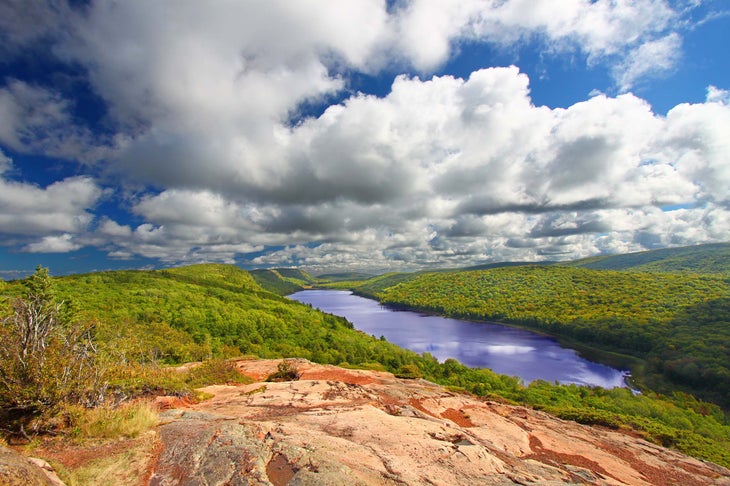
Ancestral home of the Ojibwe
The 60,000-acre “Porkies” are tucked along the shores of Lake Superior in a remote corner of the Upper Peninsula and showcase the “biggest and best track of virgin northern hardwoods in North America,” according to the Michigan Natural Features Inventory. This is Michigan’s largest state park, home to
robust black bear population, several wolf packs, 90 waterfalls, and 23 miles of Lake Superior shoreline.
A great dayhike:
The 4.3-mile Escarpment Trail combines a high rocky bluff and alpine-like vistas, with views of the park’s centerpiece: the incomparable Lake of the Clouds.
A great multiday hike:
The 17-mile Lake Superior Trail parallels the shore of Lake Superior.
Know before you go:
Lake Superior is the world’s largest freshwater lake by surface area and known as an inland sea. It gets ferocious, with increased wind and wave activity due to climate change.
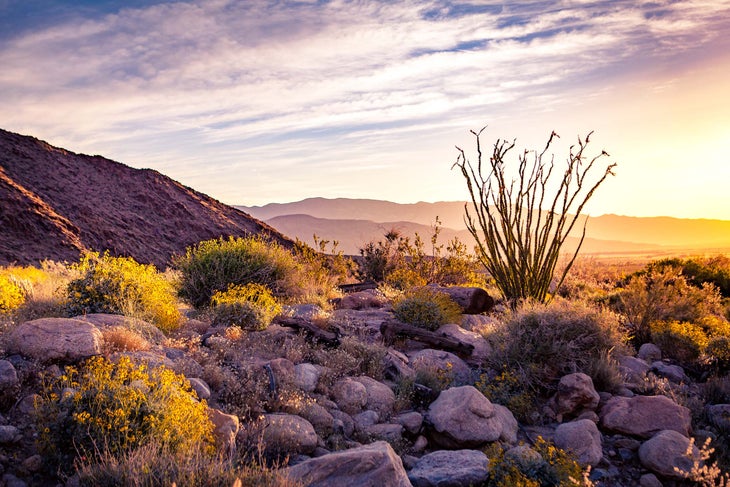
Anza-Borrego Desert State Park, California
Ancestral home of the Ipai, Tipai, and Kamia (Kumeyaay), Cahuilla and Kuupangaxwichem (Cupeño)
Established in 1933, California’s largest state park is also an International Dark Sky Park, which means it’s recognized as one of the best places for stargazing on Earth. Within the park boundaries are 12 wilderness areas and elevations that vary from 15 feet above sea level near the Salton Sea to 6,193-foot Combs Peak in the northwest. The park’s resident bighorn sheep population is not camera shy, and its springtime flower blooms following wet winters draw folks from all over the state to see a daytime show to rival the nighttime one.
A great dayhike:
The 3.25-mile Borrego Palm Canyon trail winds through a narrow, flash flood-prone canyon toward native fan palm oases, with a high probability of spotting bighorn sheep.
A great multiday hike:
The 8.8-mile trail to the summit of 5,349 Whale Peak is a steep slog, with more than 2,000 vertical feet of climbing (no pain, no gain).
Know before you go:
This may not the best destination for mid-summer, when daytime high temperatures at the park’s lower elevations average 107°F.
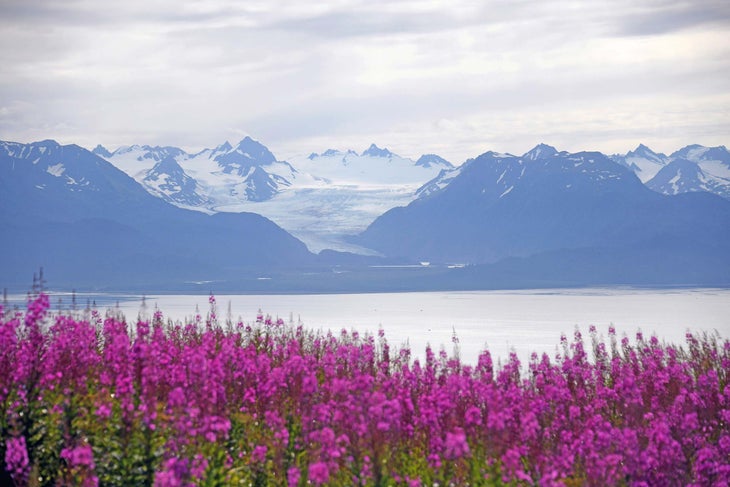
Kachemak Bay State Park and State Wilderness Park, Alaska
Ancestral home of the Dena’ina
These two connected parcels total more than 371,000 acres on the Kenai Peninsula. With a cumulative coastline exceeding 200 miles along its namesake bay, as well as the Gulf of Alaska, it’s no surprise that visitors stand a good chance of seeing sea otters, seals, porpoises, and whales. Land mammals include moose, black bear, mountain goats, coyotes, and wolves. Many avian species, such as eagles, gyrfalcons, and puffins inhabit the parks. The innermost reaches of the park have glaciated peaks that exceed 5,000 feet in elevation.
A great dayhike:
The 6.5-mile Grewingk Glacier Trail reaches the only trail-accessed glacier in the park.
A great multiday hike:
The 32-mile Tutka Backdoor Trail was completed entirely by volunteers in 2016.
Know before you go:
There is no road access to either of these parks. Visitors must utilize float planes or water taxis out of Homer, though hearty hikers might be able to access the parks from the village of Seldovia, which is also only accessible by car ferry or float plane from Homer.
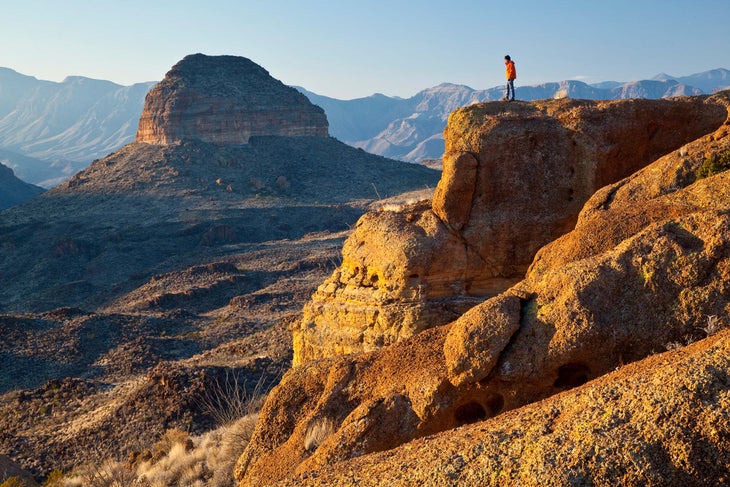
Big Bend Ranch State Park, Texas
Ancestral home of the Mescalero, Lipan, Kickapoo, Jumano, and Comanche
Not to be confused with the similarly-named Big Bend National Park, which lies less than 100 miles to its east, Big Bend Ranch (BBRSP) only fully opened to the public in 2007. The largest state park in Texas, it remains something of a working ranch, with a semi-annual roundup of the resident longhorn cattle herd.
Don’t worry, though—there are plenty of animals that don’t require chaps to view. BBRSP is home to populations of cougars, bobcats, golden eagles, peregrine falcons, zone-tailed hawks, western mastiff bats, gray fox, mule deer, coyote, seven species of owl, and six species of woodpecker.
There are two main differences between the Ranch and its national park sibling. One is water: “Despite being smaller, we have twice as many water sources,” says Park Superintendent Nate Gold. “We have a lot of riparian areas that teem with wildlife.”
The other difference? Visitors. The national park now sees an average of 500,000 people a year, while BBRSP saw just 85,000 last year.
A great dayhike:
The 5-mile West Fresno Rim Overlook Trail takes hikers to the edge of Fresno Canyon, with a spectacular view of the Soliatrios Flatirons.
A great Multiday hike:
The 22-mile Rancherias Loop offers water sources at least once a day—a rarity in this parched area of the country.
Know before you go:
Don’t come here in the summer.
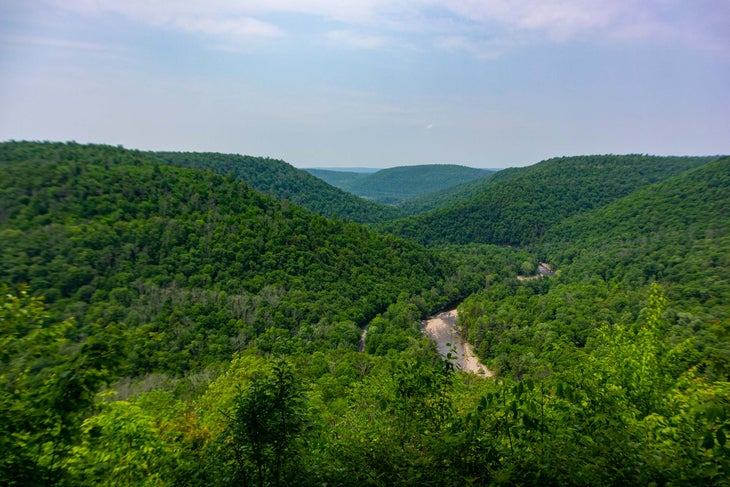
Loyalsock State Forest, Pennsylvania
Ancestral home of the Shawnee and Seneca
Pennsylvania has no shortage of state forests, but the 115,000-acre Loyalsock State Forest may be tops among them. Located northeast of Williamsport, Loyalsock is home to five natural and wild areas that mark an abrupt topographical change from the lower two-thirds of the state. “We are located in the transition zone from the ridge and valley province in the south to the more glacier-carved lands to the north,” says District Forester Rich Glinski. “We have higher elevation, steep terrain, crystal-clear sandstone creeks, and significant waterfalls and rock ledges.”
A great dayhike:
The 1.7-mile Jacoby Falls Trail accesses the 30-foot eponymous falls, considered one of the prettiest cascades in the state.
A great multiday hike:
Both the 28-mile Old Loggers Path loop and the 60-mile Loyalsock Trail offer good overnight options.
Know before you go:
Like most of Pennsylvania’s state forests, the Loyalsock is a working forest. You may encounter active timber mangement during your visit.
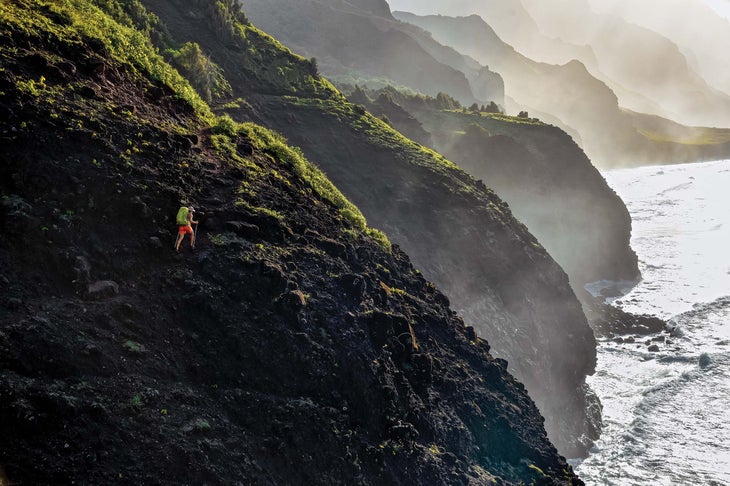
Koke’e, Waimea Canyon, Nā Pali Coast, and Ha’ena State Parks, Kaua’i, Hawaii
Ancestral home of the Kānaka Maoli
Eyeball a map of Kaua’i and you are likely to notice that a significant percentage of the island is colored green. More
than half of Kaua’i is protected through an administrative hodgepodge that includes forest reserves, natural area reserves, a wilderness preserve, a national wildlife refuge, and six state parks. Though the entire island is magnificent, the northwest—which includes the incomparable Nā Pali coast and Waimea Canyon—is particularly impressive: Picture vividly colored, striated, thousand-foot cliffs and canyons, waterfalls, caves, marshlands, and beaches. At its center stands 5,148-foot Wai’ale’ale, considered one of the wettest places in the world, with 450 inches of rain a year on average.
Though small by mainland standards, the four state parks on the Kaua’i’s northwest side—Koke’e (4,345 acres), Waimea Canyon (1,866 acres), Nā Pali Coast (6,175 acres) and Ha’ena (65 acres)—are part of an uninterrupted lattice of habitat that is home to numerous endemic bird species. One of those is Hawaii’s state bird, the nēnē, or Hawaiian goose, which nearly went extinct in the mid-20th century. Kauai’i’s nearshore waters provide habitat for a number of marine mammals—whales, dolphins, and the endangered Hawaiian monk seal—as well as sea turtles.
A great dayhike:
The 3.5-mile Alaka’i Swamp Trail follows a boardwalk, installed to protect the alpine bog environment, that winds through two steep river valleys and three bogs before ending at the rim overlooking Wainiha Valley.
A great multiday hike:
Both the 11-mile Kalalau Trail, which connects Ha’ena State Park with Nā Pali Coast State Park, and the 11.5-mile Waimea Canyon Trail are for experienced hikers only.
Know before you go:
If you are inclined to hike the Kalalau Trail, you must make reservations at least 90 days out. Kalalau is a dangerous trail, upon which numerous fatalities have occurred. There are slippery cliffs, swift water crossings, and high tides that can impact accessibility.
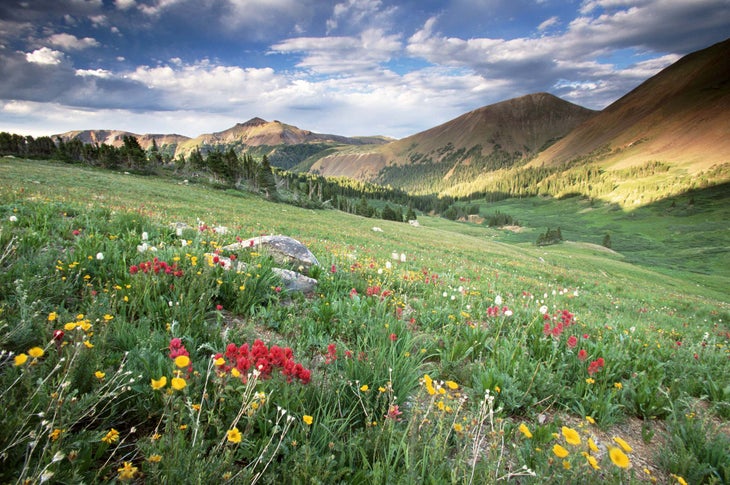
State Forest State Park, Colorado
Ancestral home of the Arapaho and Ute
The 71,000-acre State Forest State Park (SFSP) is Colorado’s largest state park by a wide margin. It serves as a very attainable alternative to the country’s fifth-most-visited national park, Rocky Mountain, just to its south. Located between the west side of the Medicine Bow Mountains and the north end of the Never Summer Range, SFSP offers elevations ranging from 8,500 to 13,000 feet and vistas that compare favorably to anywhere in the central Rockies. Moreover, SFSP boasts a singular distinction among public lands in Colorado: It is considered the state’s moose-viewing capital. Twenty-four moose were introduced into this part of the state in 1978. Subsequent transplants and successful reproduction have swelled Colorado’s moose population to nearly 3,000, about 600 of which live in the SFSP.
A great dayhike:
The Lake Agnes Trail is less than a mile long and sees a lot of traffic. It’s worth braving those crowds, however, for the unparalleled view of the horizon-defining Nokhu Crags.
A great multiday hike:
The 5.5-mile American Lakes Trail accesses its namesake lake and offers the option of continuing over Thunder Pass into Rocky Mountain National Park.
Know before you go:
Given the altitude, best to acclimatize yourself for a few days before hoisting your pack. Nearby Fort Collins has great craft breweries to help pass the time.
M. John Fayhee has been writing for Backpacker since 1986. The author of 10 books, Fayhee has hiked the Appalachian, Colorado, and Arizona trails. He lives near a very cool state park in New Mexico.
